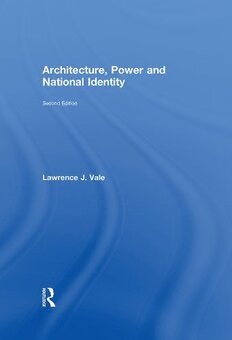
Architecture, Power and National Identity PDF
Preview Architecture, Power and National Identity
Architecture, Power, and National Identity Second edition This new, expanded edition of Architecture, Power, and National Identity examines how architecture and urban design have been manipulated in the service of politics. Focusing on the design of parliamentary complexes in capital cities across the world, it shows how these places reveal the struggles for power and identity in multicultural nation-states. Building on the prize-winning first edition, Vale updates the text and illustrations to account for recent sociopolitical changes, includes discussion of several newly built places, and assesses the enhanced concerns for security that have preoccupied regimes in politically volatile countries. The book is truly global in scope, looking at capital cities in North America and Europe, as well as in India, Brazil, Sri Lanka, Kuwait, Bangladesh, Nigeria, Tanzania, Papua New Guinea, and Australia. Ultimately, Vale presents an engaging, incisive combination of history, politics, and architecture to chart the evolution of state power and national identity, updated for the twenty-first century. Lawrence Vale is the Head of the Department of Urban Studies and Planning at MIT. He has published six previous books, including the first edition of Architecture, Power, and National Identity, which received the Spiro Kostof Award from the Society of Architectural Historians. Praise for the first edition: “Lawrence Vale’s Architecture, Power, and National Identity is a powerful and compelling work and is a major contribution to the history of urban form.” David Gosling, Town Planning Review “[Vale’s] book makes fascinating reading for anyone interested in the cultural forces behind architecture and urban design and in the ways that parliamentary and other major government buildings are emblematic of the political history and power elites of their countries. This work represents a valuable 2 expansion of the purview of design criticism by treating the designs of government officials as equal in importance to the physical designs of architects.” Michael Y. Seelig,Canadian Journal of Urban Research 3 4 Architecture, Power, and National Identity Second edition Lawrence J. Vale 5 First published 1992 by Yale University Press This edition published 2008 by Routledge 2 Park Square, Milton Park, Abingdon, Oxon, OX14 4RN Simultaneously published in the USA and Canada by Routledge 711 Third Ave, New York, NY 10017 Routledge is an imprint of the Taylor & Francis Group, an informa business © 2008 Lawrence J. Vale All rights reserved. No part of this book may be reprinted or reproduced or utilized in any form or by any electronic, mechanical, or other means, now known or hereafter invented, including photocopying and recording, or in any information storage or retrieval system, without permission in writing from the publishers. British Library Cataloguing in Publication Data A catalogue record for this book is available from the British Library Library of Congress Cataloging in Publication Data Vale, Lawrence J., 1959– Architecture, power, and national identity/Lawrence J. Vale. — 2nd ed. p. cm. Includes bibliographical references and index. ISBN-13: 978-0-415-95514-0 (hbk: alk. paper) ISBN-13: 978-0-415-95515-7 (pbk: alk. paper) 1. Capitols. 2. Architecture—Political aspects. 3. Architecture and society. I. Title. NA4195.V35 2008 6 725′.11—dc22 2007032656 ISBN 10: 0-415-95514-9 (hbk) ISBN 10: 0-415-95515-7 (pbk) ISBN 13: 978-0-415-95514-0 (hbk) ISBN 13: 978-0-415-95515-7 (pbk) 7 Contents Preface to the second edition Preface to the first edition Part1 The locus of political power 1 Capital and capitol: an introduction 2 National identity and the capitol complex 3 Early designed capitals: for union, for imperialism, for independence 4 Designed capitals after World War Two: Chandigarh and Brasília 5 Designed capitals since 1960 Part2 Four postcolonial capitol complexes in search of national identity 6 Papua New Guinea’s concrete haus tambaran 7 Sri Lanka’s island parliament 8 Precast Arabism for Kuwait 9 The acropolis of Bangladesh 10 Designing power and identity Notes 8 Illustration credits Index 9 10
